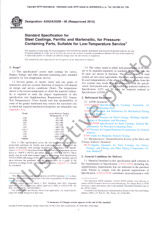We need your consent to use the individual data so that you can see information about your interests, among other things. Click "OK" to give your consent.
ASTM E3045-21
Standard Practice for Crack Detection Using Vibroacoustic Thermography
Translate name
STANDARD published on 1.12.2021
The information about the standard:
Designation standards: ASTM E3045-21
Note: WITHDRAWN
Publication date standards: 1.12.2021
SKU: NS-1046518
The number of pages: 7
Approximate weight : 21 g (0.05 lbs)
Country: American technical standard
Category: Technical standards ASTM
The category - similar standards:
Annotation of standard text ASTM E3045-21 :
Keywords:
ICS Number Code 19.100 (Non-destructive testing)
Additional information
| 1. Scope | ||||||||||||||||||||
|
1.1?PurposeThis practice covers procedures required to conduct an examination of components using vibroacoustic thermography. 1.2?ApplicationThe vibroacoustic thermography process has been used for component inspections in the aircraft, power generation, automotive, and other industries for testing new and serviced components, both coated and uncoated. Current applications are mostly targeting metallic components, but composite and ceramic component applications are under development (1.3?BackgroundVibroacoustic thermography is a new technique within the area of active thermography. The technique was first published by Henneke, et al. in 1979 (2) and has been expanded on and popularized by Favro, et al. (Note 1:?Vibroacoustic thermography is typically sensitive to tight planar defects (Note 2:?Vibroacoustic thermography is a surface examination but has demonstrated detection sensitivity for subsurface defects including back wall defects for thin components (5), (6). Care should be taken when developing vibroacoustic thermography for the detection of subsurface defects. 1.4?Warnings:? 1.4.1?WarningVibroacoustic thermography requires the energization of the test article with vibrational energy. During energization, the complete component may be excited with vibroacoustic (vibration) energy for as long as several seconds. The development of this test for a new application requires special measurements, precautions, and attention to component response. The component design engineer and the NDE engineering specialist knowledgeable of this technique should be satisfied that the test will not cause damage or reduction of service life. 1.4.2?WarningVibroacoustic thermography, like any other NDT technology, requires thorough development and testing for each application, including clear definition of the inspection objective, as well as development of objective means to distinguish between rejectable indications and conditions that should not be cause for rejection. Incomplete development and application will result in high incidence of improper rejections and high incidence of defect "misses." The images produced by many vibroacoustic thermography inspections can otherwise lead to inspector fatigue and ineffective evaluations. 1.5?This standard does not purport to address all of the safety concerns, if any, associated with its use. It is the responsibility of the user of this standard to establish appropriate safety, health, and environmental practices and determine the applicability of regulatory limitations prior to use. 1.6?This international standard was developed in accordance with internationally recognized principles on standardization established in the Decision on Principles for the Development of International Standards, Guides and Recommendations issued by the World Trade Organization Technical Barriers to Trade (TBT) Committee. |
||||||||||||||||||||
| 2. Referenced Documents | ||||||||||||||||||||
|
We recommend:
Technical standards updating
Do you want to make sure you use only the valid technical standards?
We can offer you a solution which will provide you a monthly overview concerning the updating of standards which you use.
Would you like to know more? Look at this page.




 Cookies
Cookies
